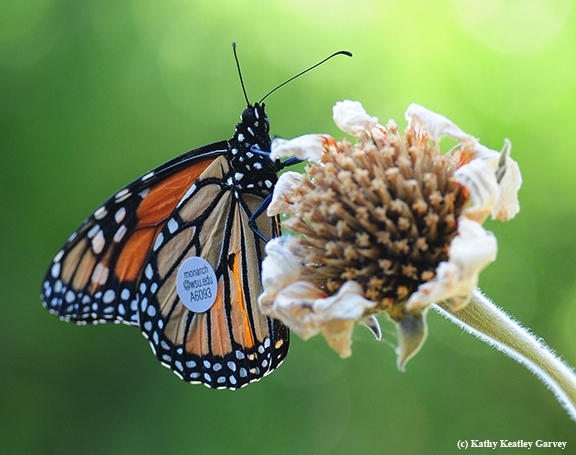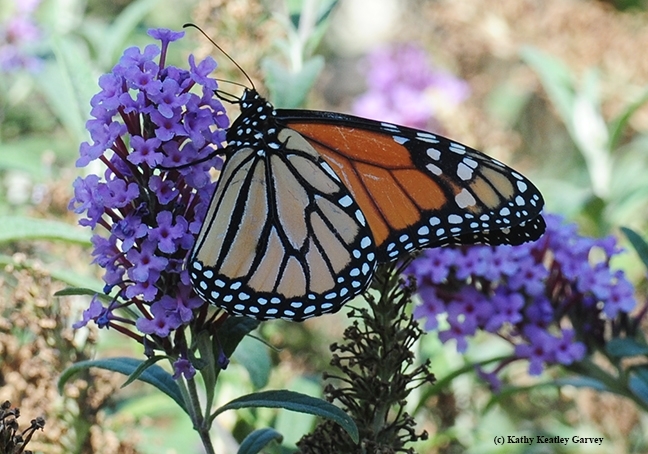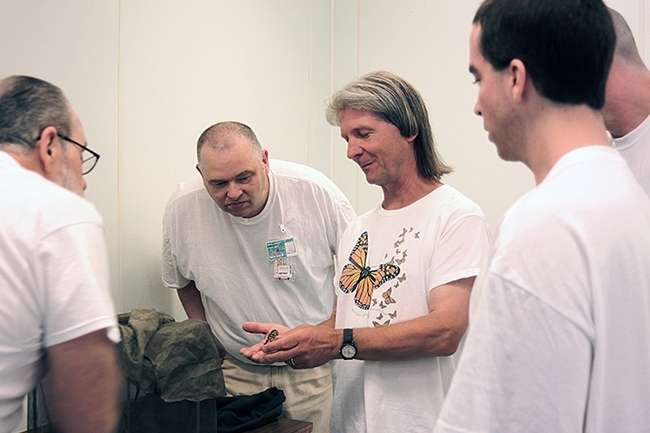
The research paper covered the first five years, 2012 to 2016, of the ongoing project. Citizen scientists tagged and released nearly 15,000 monarchs in Washington, Oregon, Idaho and British Columbia in the late summer and fall. The number recovered? Sixty.
"On average, these butterflies averaged almost 40 miles of travel each day," James told the WSU News Service. "That's pretty remarkable for such a small creature."
One of the monarchs released Aug. 28, 2016 in Ashland, Ore., by citizen scientist Steven Johnson fluttered into our yard in Vacaville, Calif., on Sept. 5, a 457-kilometer journey. We happened to be home and photographed the traveler, a male. The discal cell tag read "monarch@wsu.edu 6093." WSU is my alma mater, so double excitement!
What was the longest recorded journey? A monarch that David James released in Yakima, Wash. It was recovered near Goleta, Calif., a distance of 845 miles.
When No. 6093 stopped in our yard for some flight fuel, he sipped nectar from Mexican sunflowers (Tithonia) and butterfly bush (Buddleia davidii) and milkweed (in this case, tropical milkweed, Asclepias curassavica.)
Scientists believe that monarchs ride warm air currents (thermals) a few thousand feet from the ground. Then, they use strong upper-air currents to navigate.
It's a long, tough journey, averaging nearly 500 miles, and often with strong winds, heavy rain, or triple-digit temperatures. They need food (nectar from flowers) and often they don't escape predators, including birds, praying mantids and spiders, and such diseases as Ophryocystis elektroscirrha, a protozoan parasite.
Perhaps some day migrating monarchs will be microchipped, if a lightweight chip is invented. "Then we can just chip 100 or 200 butterflies and not tag 15,000," James pointed out.
The research paper is titled "Citizen Scientist Tagging Reveals Destinations of Migrating Monarch Butterflies, Danaus plexippus (L.) from the Pacific Northwest." (See this site for the full text).
The abstract:
The fall migration of Monarch butterflies (Danaus plexippus) in the Pacific Northwest (PNW) was studied in an unfunded citizen science project during 2012—16 by tagging 13778 reared and 875 wild Monarchs. More than a third of these Monarchs were reared by inmates of the Washington State Penitentiary (WSP) in Walla Walla, Washington. Sixty (0.41 %) tagged Monarchs were recovered from distances greater than 10 km (mean: 792.9 ± 48.0 km) with most found in California, SSW of release points. One WSP-reared Monarch was found 724 km to the SE in Utah. Monarchs tagged in Oregon flew SSE to California. No Idaho-tagged Monarchs were found in California but two were recovered at locations due south. No wild tagged Monarchs from Washington, Oregon or Idaho were recovered. Monarchs from Washington and Oregon were found during October-February at 24 coastal California overwintering sites spanning 515 km from Bolinas to Carpinteria. A single wild spring Monarch tagged in May in northern California was recovered 35 days later and 707 km ENE in Twin Falls, Idaho. This study provides compelling evidence that many Monarchs in southern and central parts of Washington and Oregon migrate south in the fall to overwintering sites along the California coast. It also provides some evidence for southerly and south-easterly vectoring of migrating Monarchs from eastern Washington and Idaho, indicating the possibility of migration to Arizona or Mexico overwintering sites. In addition to improving our understanding of Monarch migration in the PNW, this study also contributed to conservation by adding nearly 14000 butterflies to the population. The incredible involvement of incarcerated and non-incarcerated citizen scientists generated much community and media interest which in turn led to greater involvement by citizens. Increased awareness of Monarchs, their biology and conservation in the PNW has been an unexpected but important spin-off of this study."
James is grateful for all the citizen scientists assisting with the project. It would not have been possible without them. Indeed, inmates at Walla Walla State Penitentiary alone reared one-third of the monarchs. (See feature story in Entomology Today, published by the Entomological Society of America.)
Here's what you can do to help the migrating monarchs on their journey:
- Plant nectar-rich flowers. They need flight fuel to continue their journey to the overwintering sites along coastal California.
- Don't use pesticides in your garden
- Keep your eye out for tagged migrating monarchs in the late summer and fall and try to photograph them.
- Visit overwintering sites, such as Natural Bridges State Park in Santa Cruz and the Monarch Butterfly Sanctuary in Pacific Grove, and look for--and record--tagged monarchs.
- Stay up-to-date by following the Facebook page, Monarch Butterflies in the Pacific Northwest. It now has nearly 5000 followers.
Attached Images:

This male monarch, released by citizen scientist Steve Johnson of Ashland on Aug. 28, 2016, fluttered into Vacaville, Calif., on Sept. 5, a 457-kilometer journey. (Photo by Kathy Keatley Garvey)

The male monarch, No. 6093, sips nectar from a Mexican sunflower, Tithonia on Sept. 5, 2016. It traveled 457 kilometers from Ashland to Vacaville. (Photo by Kathy Keatley Garvey)

A feast! This migrating monarch from Ashland, Ore., sipped nectar from a butterfly bush, Buddleia davidii in Vacaville, Calif. (Photo by Kathy Keatley Garvey)

WSU entomologist David James, wearing a monarch t-shirt, with citizen-scientist inmates at Washington State Penitentiary, Walla Walla.

Monarchs overwintering in the Natural Bridges State Park, Santa Cruz, in 2016. (Photo by Kathy Keatley Garvey)